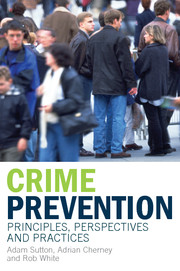3 - Social prevention
from PART 1 - THEORY
Summary
Introduction
This chapter will discuss the following topics:
the Perry Preschool Project;
the Cambridge-Somerville Youth Study;
structure and agency;
approaches to social prevention;
theory to policy;
the limits to social prevention;
crime prevention and Indigenous communities; and
the future.
In the early 1960s, educationists in the US designed an intriguing experiment. They had noted that during the initial year at school, children from severely disadvantaged backgrounds often struggled to keep up in class, and that many failed to bridge the gap in subsequent years. As a result, these youngsters were far more likely to drop out, or be expelled for disruptive behaviour. The aim of the Perry Preschool Project, as it became known, was to see what happened when infants deemed ‘at risk’ due to gross socioeconomic disadvantage received additional support before they encountered the formal education system. Between 1962 and 1967, 123 African American children aged three and four and living in poverty in inner-city Detroit were randomly assigned to an experimental or a control group. The experimental group were enrolled in a high-quality preschool program aimed at enhancing their problem solving and planning skills. Teachers also made weekly home visits. Those in the control group received no special assistance.
Results for the two groups now have been compared over 40 years. Differences are striking. Individuals who had taken part in the preschool program were much more likely to graduate from high school, had higher incomes at ages 27 and 40, and were less likely to have been arrested for a criminal offence than the non-program group.
- Type
- Chapter
- Information
- Crime PreventionPrinciples, Perspectives and Practices, pp. 32 - 47Publisher: Cambridge University PressPrint publication year: 2008



